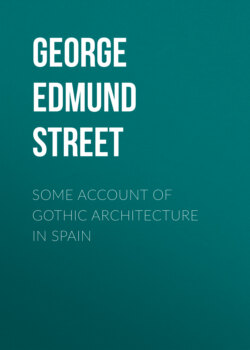Читать книгу Some Account of Gothic Architecture in Spain - George Edmund Street - Страница 12
На сайте Литреса книга снята с продажи.
CHAPTER V.
LEON.
ОглавлениеTable of Contents
IT is a ride of some six-and-thirty or forty miles from Benavente to Leon. The road follows the course of the valley of the Esla all the way, and, though it is as nearly as possible level throughout, it is impassable for carriages. This is characteristic of the country; the Spaniards are content to go on as their fathers have done before them, and until some external friend comes to make a railway for them, the people of Benavente and Leon will probably still remain as practically isolated from each other as they are at present.
The valley is full of villages, as many as ten or twelve being in sight at one time on some parts of the road. None of their churches, however, seem to be of the slightest value. They are mostly modern and built of brick, though some have nothing better than badly built cob-walls to boast of; and their only unusual feature seems to be the great western bell-gable, which is generally an elevation above the roof of the whole width of the western wall, in which several bells are usually hung in a series of openings. The villages, too, are all built of cob; and as the walls are either only half-thatched or not thatched at all, they are gradually being worn away by the rains, and look as forlorn and sad as possible. One almost wonders that the people do not quit their hovels for the wine-caves with which every little hill near the villages is honeycombed, and upon which more care seems to be bestowed than upon the houses. In these parts the peasants adorn the outside of their houses with plenty of whitewash, and then relieve its bareness with rude red and black paintings of sprigs of trees, arranged round the windows and doors.
The cathedral of Leon is first seen some three or four hours before the city is reached. It stands up boldly above the well-wooded valley, and is backed by a noble range of mountain-peaks to the north; so that, though the road was somewhat monotonous and wearying, I rode on picturing to myself the great things I was soon to see. Unfortunately I visited Leon a year too late, for I came just in time to see the cathedral bereft of its southern transept, which had been pulled down to save it from falling, and was being reconstructed under the care of a Madrilenian architect—Señor Lavinia. I saw his plans and some of the work which was being put in its place, and the sight made me wish with double earnestness that I had been there before he had commenced his work! In England or in France such a work would be full of risk, and might well fill all lovers of our old buildings with alarm; but in Spain there is absolutely no school for the education of architects, the old national art is little understood and apparently very little studied, and there are no new churches and no minor restorations on which the native architects may try their prentice hands. In England for some years we have lived in the centre of a church-building movement as active and hearty perhaps as any ever yet known; our advantages, therefore, as compared with those possessed by foreigners generally, are enormous; whilst perhaps, on the other hand, in no country has so little been done as in Spain during the present century. Yet in England few of us would like to think of pulling down and reconstructing one side of a cathedral, and few would doubt that art and history would lose much in the process, even in the hands of the most able and conservative architect.
The two great architectural features of Leon are the cathedral and the church of San Isidoro; and to the former, though it is by much the most modern of the two, I must first of all ask my readers to turn their attention.
Spaniards are rightly proud of this noble church, and the proverbs which assert its pre-eminence seem to be numerous. One, giving the characteristics of several cathedrals, is worth quoting:—
